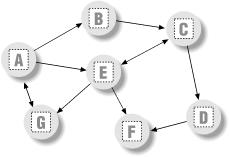Graph Searching
Many problems can be represented as a graph, which is a set of states with transitions (“arcs”) that lead from one state to another. For example, planning a route for a trip is really a graph search problem in disguise -- the states are places you’d like to visit, and the arcs are the transportation links between them.
This section presents simple Python programs that search through a directed, cyclic graph to find the paths between a start state and a goal. Graphs can be more general than trees, because links may point at arbitrary nodes -- even ones already searched (hence the word “cyclic”).
The graph used to test searchers in this section is sketched in Figure 17-1. Arrows at the end of arcs indicate valid paths (e.g., A leads to B, E, and G ). The search algorithms will traverse this graph in a depth-first fashion, and trap cycles in order to avoid looping. If you pretend that this is a map, where nodes represent cities, and arcs represent roads, this example will probably seem a bit more meaningful.

Figure 17-1. A directed graph
The first thing we need to do is choose a way to represent this graph in a Python script. One approach is to use built-in datatypes and searcher functions. The file in Example 17-15 builds the test graph as a simple dictionary: each state is a dictionary key, with a list of keys of nodes it leads to (i.e., its arcs). This file also defines ...
Get Programming Python, Second Edition now with the O’Reilly learning platform.
O’Reilly members experience books, live events, courses curated by job role, and more from O’Reilly and nearly 200 top publishers.

